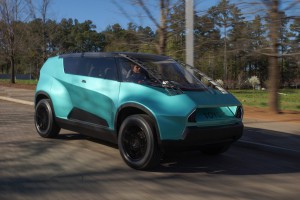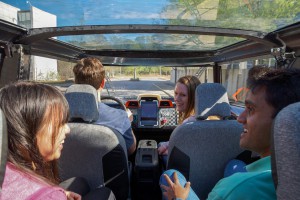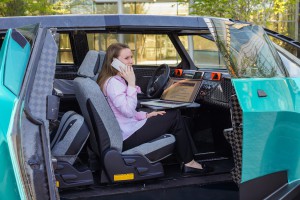
Graduate students at Clemson University’s International Center for Automotive Research, worked with Toyota to develop UBox.
As the world wrings its hands over the fate of an automotive industry that will eventually be run by an allegedly apathetic generation of Millennials, Toyota and Clemson are showing that future appears to be pretty bright.
After a two-year partnership between the Japanese automaker and Clemson University’s International Center for Automotive Research, a group of graduate students unveiled a concept called uBox.
The concept, which was born out of collaboration of the two called Deep Orange, is designed to appeal to the next generation of car buyers: Gen Z. Deep Orange, named after the university’s well-known orange athletic uniforms, gives the students involved a hands-on experience in different aspects of automotive development.
“Deep Orange gives students’ hands-on experience with the entire vehicle development process, from identifying the market opportunity through the vehicle build,” said Johnell Brooks, an associate professor in Clemson’s graduate engineering program. “It’s like automotive boot camp for the real world, and it wouldn’t happen without industry partners like Toyota.”
(Want to buy a piece of history? Hillary Clinton’s old car is for sale! Click Here for the story.)
The uBox looks like a small minivan-styled vehicle with a muscular feel; however, the students have designed it to be much more than that. The interior can be reconfigured to accommodate a variety of functions, including plenty of cargo hauling with a low floor and reconfigurable, removable seats on sliding tracks that can be nested.

A unique pultrusion technique developed by the students that allows composite carbon fiber rails bonded with aluminum to support a curved glass roof.
Additionally, the vents, dashboard display bezels and door trim can be personalized and made with 3-D printing technology. The would also be an online community for owners where they can share design ideas.
The uBox would be powered by a compact, dual-purpose, all-electric powertrain providing a fun driving experience and emission-free stationary energy to power consumer electronics, power tools or other devices through various 110-volt sockets located throughout the interior and exterior, according to the program.
(Click Here for details about the continued slide of small car sales.)
While an imaginative interior and exterior isn’t all that surprising from a focused group of students, there was one particular effort that impressed Toyota officials: a unique pultrusion technique developed by the students that allows composite carbon fiber rails bonded with aluminum to support a curved glass roof.
“The roof pultrusion was something unexpected and very interesting when they first started talking about the concept,” said Toyota Executive Program Manager Craig Payne. “The fact that they were able to achieve an industry-first manufacturing technique as students speaks volumes for this program.”
The concept gets its public unveiling at the Society of Automotive Engineers World Congress in Detroit on April 12, but in the meantime, the experience gained by the students will put them on a path to make a bigger impact in the industry.

The uBox concept is designed to provide maximum flexibility for its owners who may need a minivan one day and a sport-ute the next.
“The collaboration with Toyota was extremely fruitful,” said Paul Venhovens, endowed chair for automotive systems integration at CU-ICAR.
(To see more about Ford’s plans to make over its headquarters campus, Click Here.)
“The Toyota management team constantly challenged the students with justifying their design and engineering decisions based on brand essence, real-world customers and what the students believed the future would embrace. This experience can simply not be gained from a text book.”
